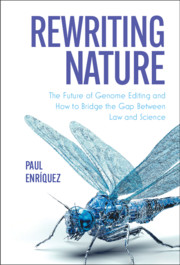Book contents
- Rewriting Nature
- Rewriting Nature
- Copyright page
- Dedication
- Summary of Contents
- Contents
- Figures
- Foreword
- Acknowledgments
- Table of Cases
- Abbreviations
- 1 A Momentous Time for Humankind
- 2 How an Idea Became a Reality
- 3 What Is Genome Editing?
- 4 Molecular Paraphernalia
- 5 What Can Genome Editing Be Used for?
- 6 Redesigning Food
- 7 Regulating Bioengineered Food
- 8 Redesigning Humanity
- 9 DNA and the Administrative State
- 10 Constitutional Predicaments
- 11 Science, Law, and Policy
- 12 Epilogue
- Index
6 - Redesigning Food
Published online by Cambridge University Press: 11 June 2021
- Rewriting Nature
- Rewriting Nature
- Copyright page
- Dedication
- Summary of Contents
- Contents
- Figures
- Foreword
- Acknowledgments
- Table of Cases
- Abbreviations
- 1 A Momentous Time for Humankind
- 2 How an Idea Became a Reality
- 3 What Is Genome Editing?
- 4 Molecular Paraphernalia
- 5 What Can Genome Editing Be Used for?
- 6 Redesigning Food
- 7 Regulating Bioengineered Food
- 8 Redesigning Humanity
- 9 DNA and the Administrative State
- 10 Constitutional Predicaments
- 11 Science, Law, and Policy
- 12 Epilogue
- Index
Summary
Feeding the world and achieving food security has become a major goal of biotechnology. The United Nations estimates that the world population will rise to nearly ten billion people by 2050. To confront challenges in global agriculture, scientists have engineered crops with specific traits to improve crop nutritional content and yields, and minimize the impact of suboptimal environmental conditions. This strategy led to the development and global commercialization of genetically modified (GM) crops, which in turn ignited fervid opposition to genetically modified organisms (GMOs) by many groups worldwide. To elucidate the basis of GMO controversies, this chapter dives into the science of GMOs. It offers a detailed account of the numerous techniques that scientists use to make GMOs and examines the advantages, limitations, and potential risks associated with each technique. The chapter further undertakes a comprehensive examination of the current state of the primary scientific literature concerning perceived health and environmental risks commonly associated with GMOs. The chapter’s primary aim is to furnish a succinct resource that renders dense scientific information related to GMOs accessible to all readers.
Keywords
- Type
- Chapter
- Information
- Rewriting NatureThe Future of Genome Editing and How to Bridge the Gap Between Law and Science, pp. 192 - 243Publisher: Cambridge University PressPrint publication year: 2021



